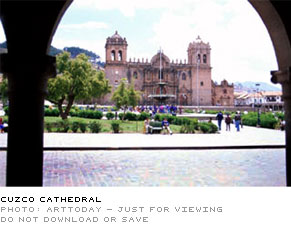|
In 1993, The 25th Congress of Americanists held in Ciudad de la Plata, Argentina, declared the city of Cuzco, "Archeological Capital of South America". Cuzco is set in the Andes mountains in the south of Peru; it is the capital of the Peruvian department of the same name and lies on a plateau watered by the Huataney River.
Inhabited by nomads and shepherds since 5,000 years B.C., it was founded by Manco Capac and Mama Ocllo in the 14th century and became the capital of the Incas with Pachucutec in the half of the 15th century. In 1533, the first Spanish conquerors arrived and on March 23th,1534, Francisco Pizarro founded the "most noble and great city of Cuzco", but it was not until 1572, with the defeat of Tupac Amaru, that the region was pacified. By the time of the greatest splendor of the Inca empire, called Tahuantinsuyo, its capital Cuzco, was a very well planned and organized city with straight stone-paved streets and channels distributing drinking water.
Great plazas, civil buildings and ceremonial palaces, gave the city a monumental character. The Spaniards respected the city plan and constructed buildings on the herculean foundations of the Incas. Even today, huge constructions co-exist, where reminiscences of both civilizations can be found. Of
the Inca ruins, the most important ones include, Qasana, the old
home of Pachacutec and Qoraquora, palace of Inca Roca. Two great earthquakes have changed the city's appearance, one in 1650 that destroyed a large number of colonial buildings and another in 1950 that damaged many old and new buildings.
However, no tragedy has stopped the progress of the city and the people of Cuzco, who have always been characterized by their joy, hospitality and marvelous traditional fiestas which are still alive in the life and spirit of its people. Cuzco's holiday calendar has a wide variety and is composed of many different celebrations, properly distributed through the year, where ancient pre-Hispanic rites are mixed with Christian traditions, leading to a very special personality. The holiday year ends with "Santuranticuy" that has been held on December 24 since the Spaniards arrived and at present is the oldest, largest, and high quality popular art fair in Peru. With its glorious past, its intense present and promising future, Cuzco is the city that summarizes the pride of the Peruvians and makes the spirit of all Latinos vibrate. At present, its inhabitants have accepted the permanent challenge of protecting this cultural heritage and projecting its spirit to the entire world. Cuzco, Peru, an example of the best of the latin spirit. |
|
|
 Can
a city be considered the archeological capital of South America?
Can
a city be considered the archeological capital of South America?